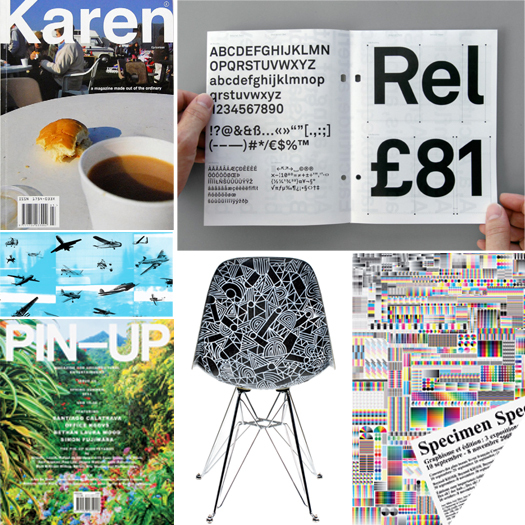
December 31, 2009
Graphic Design is Dead, Long Live Graphic Design

Clockwise from top left: Karen, Karen, issue 3, 2007; Laurenz Brunner, Akkurat typeface, 2005. Courtesy Lineto; Fanette Mellier, Specimen, 2008; Mike Perry, Eames Eiffel Side Chair, 2010; Felix Burrichter and Dylan Fracareta, Pin-Up, Issue 10, Spring/Summer 2011; cyan, Flieger, 2010. Courtesy Maharam Digital Projects
Editor’s note: The following essay was completed prior to Rick Poynor’s review, “Read All That? You Must be Kidding Me?” of January 2012 when Graphic Design: Now in Production was completing its run at the Walker Art Center in Minneapolis. The second venue for the exhibition, hosted by the Cooper-Hewitt National Design Museum, opens tomorrow on Governor’s Island in New York City.
“Graphic design is dead. Long live graphic design”
— A note on emerging cultural relevancy for graphic design
Graphic design has arrived. Not that it hadn’t already before. But the recently closed exhibition Graphic Design: Now in Production (GDNiP) at the Walker Art Center (and scheduled for future exhibitions at the Cooper-Hewitt National Design Museum, New York; Hammer Museum, Los Angeles; Southeastern Center for Contemporary Art, Winston-Salem NC) presents a cohesive understanding of graphic design as a discipline trying to examine its own sense of self. The catalogue makes reference to two previous exhibitions on graphic design of similar scope, Graphic Design in America (1989) and Mixing Messages (1996), which had presented graphic design as a collection of individual practices or current themes, but GDNiP pursues graphic design in a much more introspective way. It theorizes graphic design as a practice with its own history, vocabulary, methods and aspirations. It is the position of this writer that to claim graphic design is a cultural enterprise is to understand it as an expanding disciplinary project. It is no longer simply a profession, a service, a tool or a means to create desire. Obviously it still serves all those roles, but it has also exceeded them. The co-organizers of the exhibition, Andrew Blauvelt and Ellen Lupton say as much in their introduction to the catalogue, “We have sought out innovative practices that are pushing the discourse of design in new directions, expanding the language of the field by creating new tools, strategies, vocabularies, and content.”[1]
The respective directors of the two institutions from which Blauvelt and Lupton hail, the Walker Art Center and the Cooper-Hewitt Museum respectively, are not so generous in their assessment. Olga Viso of the Walker and Bill Moggridge, of the Cooper-Hewitt, abide by the conventional perception that graphic design remains a service. In their view, “The field has changed dramatically […] Design practice has broadened its reach, expanding from a specialized profession to a widely deployed tool.”[2] in fact, graphic design has always been a tool. The Directors let slip their perception that design is still solely about “problem-solving.” But as Daniel van der Velden asks in one of the included catalogue essays, “Research and Destroy: Graphic Design as Investigation,” (2006), what exactly does graphic design solve: “[W]hat is the problem? Is it scientific? Is it social? Is it aesthetic? […] Or is the problem the fact that there is no problem?”[3] When not defined by problem-solving, graphic design is able to occupy a (dialectical) position between its autonomy ― a body of knowledge and formal operations that separate it from the contingencies of life ― and the pressures of social, political and cultural determinism that actively seek to subsume it. Untethered, graphic designers are thus capable of questioning the assumptions and limits that guide design practice.
Unlike painting or sculpture — but like architecture — graphic design is still governed by certain limits. Graphic designers, like architects, still abide by professional codes of practice. To ignore such limits is to jeopardize one’s relationship with a client or the public at large, which is perhaps why Viso and Moggridge find it difficult to consider graphic design defined by something other than its traditional service role. But when it is approached as a discipline, graphic design has the potential to question the codes that constitute and enforce its limits. By exploring the ways that graphic design is formally determined, it becomes possible for design to discover, invent and assert itself as a unique way to envision and communicate. Van der Velden extends his position by emphasizing that, “The true investment is the investment in design itself, as a discipline that conducts research and generates knowledge ― knowledge that makes it possible to seriously participate in discussions that are not about design.”[4]
Van der Velden’s emphasis recalls the techniques of twentieth-century avant-garde practice by rejecting the instrumentalization of capital in order to reterritorialize the object of graphic design from within. Yet his position is not an absolute or wholesale rejection of the relationship with consumer capital. Rather, Van der Velden recognizes that in the absence of a client, capital’s representative, it is possible to weigh and reterritorialize the codes of practice that were otherwise out-of-bounds. Quoting from a 2010 interview published on Design Observer, Van der Velden uses the term “speculative design” to describe design’s engagement when given the opportunity to ask “What if…?” “When discussed from the point of view of critique, speculative design anticipates a reality, and uses that as a critical device.”[5] Much of the work included in GDNiP speculative because it takes the position that graphic designers already inhabit a world where their creations are already valued not for their abilities to “solve problems,” but for what they suggest about the state of graphic design as an expression of ideas.
In fact, the catalog of GDNiP serves as an example of research inquiry advanced by Van der Velden. The catalogue includes the standard fare of curatorial essays that serve to contextualize the work exhibited, but more importantly and more unusual, the curators have included essays previously published elsewhere. The exhibition includes work produced from 2000 to the present, and the inclusion of written material published during the same period suggests that the essays (theory) are on the same footing as the curated design work: Essays and artifacts are equally representative of how design has developed over the past ten years as a disciplinary practice. For graphic design to place visual work on the same footing as writing is to understand that it is a practice which has achieved a certain amount of autonomy: it is beginning to question the codes of practice which define inclusion and their limits.
But perhaps most importantly in my opinion, the selected essays do much of the “heavy lifting,” which is to say that the selected essays ― while not originally written to function as a whole ― provide a significant portion of the theoretical insight with which to interpret the work selected for GDNiP. Published in chronological order and distributed between thematic essays written by the co-curators, the historical essays do not refer specifically to the work included in the GDNiP exhibition, but they do weave together an understanding that forms a pervasive subtext throughout the selected design work. That subtext begins to theorize design’s attempt to express authorial control over its own output. It presents a certain strain of contemporary graphic design as a “Trojan Horse,” one that mimics the necessities of visual communication for a client-based profession while surreptitiously engaging in the broadening of graphic design’s cultural and social relevancy. Van der Velden’s position can be seen as part of a theory arc that includes Lupton’s “Design as Producer” (1998); Michael Rock’s “Fuck Content” (2005); Lorraine Wild’s “Unraveling”(2011) (to which I would add “The Macramé or Resistance,” (1998) the essay upon which “Unraveling” largely extends); Steven Heller’s “Design Entrepreneur 3.0” (2011) which builds upon thoughts laid out in his essay “The Attack of the Designer Authorpreneur” (1998); and James Goggin’s “Practice from Everyday Life,” (2009). And while the thematic contributions of the various co-curators are helpful, they largely form their own discrete interpretations of the selected design work. The essays noted above, however, stitch together a grander questioning of design’s place in society. Such questions are posed by Goggin’s contribution: (Context) Do designers occupy a sufficiently unique perspective? (Relevance) Does design contribute anything towards understanding ourselves, our society? (Meaning) And ultimately, can designers have an impact on culture?
The exhibited work and catalogue of Graphic Design: Now in Production admirably demonstrate design’s continuing foray into deeper self-examination while simultaneously revealing design’s outward-looking potential to with an ever widening list of other cultural territories like conceptual, literature, politics and philosophy. Given time, as it adds to its vocabulary of engagement, I am optimistic that the discipline will mature in critical significance as well.
[1] Andrew Blauvelt and Ellen Lupton, “Introduction,” Graphic Design: Now in Production, A. Blauvelt and E. Lupton, eds. (Minneapolis: Walker Art Center, 2011), p.10.
[2] Bill Moggridge and Olga Viso, “Director’s Foreward,” Graphic Design: Now in Production, A. Blauvelt and E. Lupton, eds. (Minneapolis: Walker Art Center, 2011), p.6.
[3] Daniel van der Velden, “Research and Destroy: Graphic Design as Investigation,” Graphic Design: Now in Production, A. Blauvelt and E. Lupton, eds. (Minneapolis: Walker Art Center, 2011), pp.17–18.
[5] Daniel van der Velden, “Conversation with Daniel van der Velden of Metahaven,” Interview with William Drenttel, DesignObserver. (Accessed January 8, 2012.)
Observed
View all
Observed
By David Cabianca
Related Posts

Business
Courtney L. McCluney, PhD|Essays
Rest as reparations: reimagining how we invest in Black women entrepreneurs

Design Impact
Seher Anand|Essays
Food branding without borders: chai, culture, and the politics of packaging

Graphic Design
Sarah Gephart|Essays
A new alphabet for a shared lived experience

Arts + Culture
Nila Rezaei|Essays
“Dear mother, I made us a seat”: a Mother’s Day tribute to the women of Iran
Recent Posts
Courtney L. McCluney, PhD|Essays
Rest as reparations: reimagining how we invest in Black women entrepreneurs Food branding without borders: chai, culture, and the politics of packaging Why scaling back on equity is more than risky — it’s economically irresponsible Beauty queenpin: ‘Deli Boys’ makeup head Nesrin Ismail on cosmetics as masks and mirrorsRelated Posts

Business
Courtney L. McCluney, PhD|Essays
Rest as reparations: reimagining how we invest in Black women entrepreneurs

Design Impact
Seher Anand|Essays
Food branding without borders: chai, culture, and the politics of packaging

Graphic Design
Sarah Gephart|Essays
A new alphabet for a shared lived experience

Arts + Culture
Nila Rezaei|Essays

 David Cabianca teaches graphic design at York University in Toronto, Canada and is currently completing an MA in the Design Writing Criticism program at the University of the Arts London, London College of Communication. He is also one of the co-organizers of the upcoming conference, “Blunt: Explicit and Graphic Design Criticism Now,” sponsored by the AIGA Design Educators Community to be held at Norfolk, VA in April 2013.
David Cabianca teaches graphic design at York University in Toronto, Canada and is currently completing an MA in the Design Writing Criticism program at the University of the Arts London, London College of Communication. He is also one of the co-organizers of the upcoming conference, “Blunt: Explicit and Graphic Design Criticism Now,” sponsored by the AIGA Design Educators Community to be held at Norfolk, VA in April 2013.